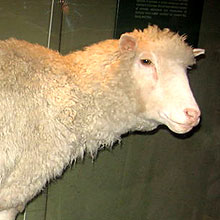Dolly at 10: Whither the Clones?
Ten years ago last week, on February 22, the world first heard about the birth of Dolly the sheep, who was born on July 5, 1996, and died on February 14, 2003. In 1997, the announcement that Scottish geneticist Ian Wilmut had created an exact genetic duplicate of an adult ewe caught almost everyone by surprise. Until then, the public thought of clones in terms of science fiction–clone armies in Star Wars and Adolf Hitler redux in The Boys from Brazil.

The appearance of a fuzzy little lamb created a sensation, generating a great deal of talk about when humans–and pet poodles and perhaps saber-toothed tigers–would be cloned. Surely, it was said, if a sheep could be xeroxed, so could, well, Hitler, if there is any of his DNA around. Or my grandmother. Or Mother Teresa. Or Genghis Khan.
Obviously, none of this has happened. A few pets have been cloned, and at least two hoaxes have been perpetuated in which people claimed to have cloned humans: one in South Korea that involved a cloned human embryo, and the weird claim by the Raelians that they created a human clone that was brought to term and was said to be living in Florida. It turns out to be extremely difficult to clone a mammal, and those animals that are cloned tend to develop rare disorders that shorten their lives. This is what happened to Dolly, who suffered from premature aging and a rare form of arthritis before being put down after being afflicted with lung disease.
There is also a powerful moral issue about cloning humans: whether it should be done or not given the health issues of clones and the much larger issue of what it means to be a human being. What legal status would a clone have? Would clones be grown to provide spare organs to “natural-borns”? Would there be a temptation to further bioengineer clones by manipulating their DNA in ways that right now are considered unethical in humans? Geneticists struggling to be allowed to clone embryos for stem-cell research have all sworn that they have no interest in cloning finished humans, and I believe them, but that doesn’t mean that a scientist somewhere isn’t trying.
Of course we already have millions of clones in the world: identical twins, who share identical DNA. And some thinkers and scientists believe that we should produce clones–and that once the kinks are worked out, it will actually be a safer way to reproduce humans. Read my friend Greg Stock’s book Reinventing Humans: Our Inevitable Genetic Future, which argues that cloning humans is inevitable and will one day be about as controversial as heart surgery is today. A century ago, few surgeons would venture into the heart, then considered the repository of the soul.
As of now, the failure of science (as far as we know) to actually clone a human–and the ethical reluctance of most scientists to take this step–means that we haven’t had to face the issues. I suspect that by the time another 10 years has gone by, we may be hearing for real about a baby clone being born.
As we watch this human Dolly laughing and crying and spitting up formula like a “natural” baby, how will we feel?
Keep Reading
Most Popular
Large language models can do jaw-dropping things. But nobody knows exactly why.
And that's a problem. Figuring it out is one of the biggest scientific puzzles of our time and a crucial step towards controlling more powerful future models.
How scientists traced a mysterious covid case back to six toilets
When wastewater surveillance turns into a hunt for a single infected individual, the ethics get tricky.
The problem with plug-in hybrids? Their drivers.
Plug-in hybrids are often sold as a transition to EVs, but new data from Europe shows we’re still underestimating the emissions they produce.
Stay connected
Get the latest updates from
MIT Technology Review
Discover special offers, top stories, upcoming events, and more.